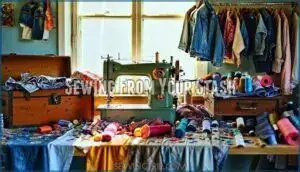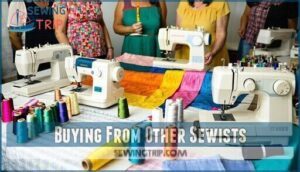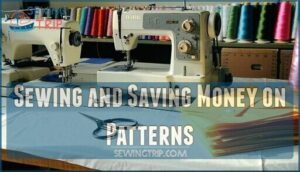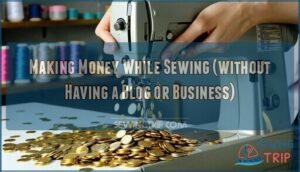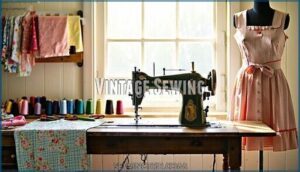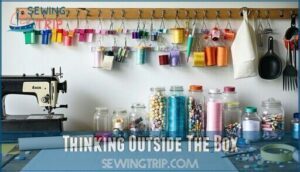This site is supported by our readers. We may earn a commission, at no cost to you, if you purchase through links.
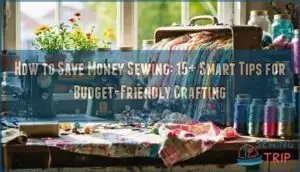
Hunt for remnants and end-of-bolt pieces that cost a fraction of full-price yardage. Thrift stores are goldmines for both fabric and clothes you can repurpose.
Share supplies with fellow sewists and take advantage of pattern sales rather than impulse buying. Think of every coffee purchase as equivalent to thread or buttons – those small expenses add up quickly.
Smart sewists know the real secrets lie in strategic timing and creative resourcefulness.
Table Of Contents
Key Takeaways
- Shop your stash first – You’ll discover forgotten treasures in your own fabric collection and avoid unnecessary purchases by planning projects around materials you already own.
- Hunt for remnants and thrift store finds – You can slash fabric costs by 30-70% through warehouse remnants, factory overruns, and repurposing secondhand clothing into quality materials.
- Time your pattern purchases strategically – You’ll build a versatile collection by catching sales at major retailers, using free online patterns, and learning to alter existing designs rather than buying new ones.
- Think creatively about supplies and tools – You can substitute household items for expensive sewing tools, join sewing groups to share resources, and use cashback apps to earn money on your purchases.
Is Sewing Expensive?
Sewing’s expense depends on several key factors that you control.
Your skill level substantially impacts costs—beginners often waste fabric through mistakes, while experienced sewers maximize every scrap.
Experienced sewers turn every fabric scrap into opportunity—beginners turn opportunity into expensive mistakes.
Project complexity matters too; simple tote bags cost far less than custom-made blazers requiring specialty fabrics and notions.
Fabric choice impact drives most sewing expenses.
Premium materials like silk or wool can cost $30+ per yard, while cotton prints run $8-15.
However, smart sewers know that budget-friendly sewing doesn’t mean cheap results.
You’ll discover long-term savings when you master sewing on a budget techniques like shopping your stash first, hunting remnants, and choosing versatile fabrics.
To further reduce expenses, consider repurposing old fabrics for new projects.
The real question isn’t whether sewing’s expensive—it’s whether you’re ready to learn money-saving strategies that transform this craft into an economical hobby.
Sewing and Saving Money on Fabric, Notions, Tools, and Machines
You don’t need to spend a fortune on fabric, notions, and sewing supplies to create beautiful handmade pieces that rival store-bought items.
Smart shopping strategies like exploring your existing stash, hunting for remnants, and repurposing materials can slash your crafting costs while keeping your creative projects flowing, using smart strategies.
Sewing From Your Stash
Shop your existing fabric stash before hitting the store – it’s like discovering buried treasure in your own home.
Take inventory of what you’ve got, then plan projects around those materials. You’ll find creative combinations you never considered before.
Repurpose old clothes into fresh fabric, and upcycle fabric scraps into smaller items like bookmarks or coasters.
Smart stash management and refashioning stash pieces transforms forgotten materials into exciting new creations.
Avoid Impulse Buys and Sales
That gorgeous fabric calling your name from the sale rack? Take a breath before you buy.
Smart sewists plan purchases around actual projects, not tempting discounts. Create a shopping list with specific needs, then stick to it.
Resist those "just in case" fabrics that’ll gather dust. Your sewing budget will thank you when you delay gratification and focus on purposeful buying, which involves smart decisions to ensure you’re making the most of your money.
Buying From Other Sewists
Your fellow sewists often have treasure troves waiting to be discovered. Connecting with other crafters opens doors to incredible sewing savings tips that’ll stretch your sewing budget further than you’d imagine.
Here’s where to find community discounts and build your sewing frugality skills:
- Destash sales – Members clearing out excess supplies at rock-bottom prices
- Fabric swaps – Trade materials you’ll never use for fresh inspiration
- Pattern trades – Exchange designs without spending a dime
- Bulk buying groups – Split large orders for better per-yard pricing
- Sewing groups – Local meetups where deals flow freely
Thrift stores often offer economical secondhand finds.
Finding Remnants From Manufacturers or Warehouses
Beyond retail stores, factory excess and warehouse remnants offer incredible savings for savvy sewists.
Contact local textile manufacturers directly—they often have surplus materials collecting dust.
When requesting remnants, ask about large pieces that provide flexibility for multiple projects.
Many warehouses sell discount fabric online at 30-70% below retail prices, making inventory remnants your secret weapon for cheap fabric sources.
Fabric Warehouse stocks a wide selection of discounted fabric remnants, providing durable solutions for various sewing needs.
| Source Type | Typical Savings | Best For | Average Piece Size | Contact Method |
|---|---|---|---|---|
| Textile Factories | 50-70% off retail | Designer fabrics, specialty materials | 2-10 yards | Phone/email direct |
| Fashion Warehouses | 30-60% off retail | Seasonal fabrics, trendy prints | 1-5 yards | Online platforms, visits |
| Mill Overruns | 40-80% off retail | Basic cottons, canvas, denim | 5-25 yards | Industry contacts |
| Jobber Suppliers | 25-50% off retail | Mixed inventory, sample cuts | 0.5-3 yards | Wholesale websites |
| Clearance Fabric Sales | 20-40% off retail | End-of-line colors, discontinued | 1-8 yards | Store newsletters, apps |
Thrifting for Fabric
Your local thrift stores are goldmines for cheap fabric sources and vintage textiles.
Hunt through racks of secondhand clothing to find unique materials perfect for fabric repurposing. That dated floral dress becomes quilting squares, while men’s shirts offer quality cotton.
Always wash thrift store finds thoroughly before starting your sustainable sewing projects—you’ll discover amazing upcycle fabric scraps at unbeatable prices.
Sewing and Saving Money on Patterns
You don’t need to spend a fortune building your pattern collection when smart shopping strategies can slash your costs dramatically.
Whether you’re hunting for free downloads, timing sales perfectly, or learning to modify existing patterns into multiple designs, you’ll discover that creativity beats cash every time.
Be Cautious With Buying PDF Patterns on Sale
Those tempting PDF pattern sales can drain your wallet faster than you’d expect.
While digital sewing patterns seem budget-friendly, hidden costs add up quickly.
- Printing Costs – Calculate ink and paper expenses before buying
- Pattern Compatibility – Verify your printer handles the file format properly
- Layered Options – Check if patterns include size layers for easy printing
- File Management – Consider storage space for your growing digital collection
Take Advantage of Sales on Paper Patterns
Paper patterns offer incredible value when you catch them on sale.
Sign up for pattern sales alerts from major retailers like Joann’s and Butterick—their frequent promotions can slash prices by 50-70%.
These discount pattern sources let you build a solid collection without overspending.
Smart pattern storage ideas help preserve your investment, while pattern alteration savings multiply each purchase’s potential through creative modifications.
The discount pattern sources are essential for maximizing savings and building a versatile collection.
Utilize Free Patterns
Hunt down free pattern sources to slash your sewing budget without sacrificing quality.
These digital treasures offer endless possibilities for creative projects while keeping costs minimal.
- Browse designer blogs for promotional free sewing tutorials and PDF patterns
- Subscribe to newsletters from pattern companies offering exclusive free patterns
- Join online communities like Reddit’s r/freepatterns for affordable sewing patterns
- Check social media for pattern giveaways and contests
- Explore library sewing resources for garment creation guides and pattern modification tips
Explore Pattern Books
When you’re hunting for sewing patterns without breaking the bank, pattern books offer incredible value that individual patterns simply can’t match.
Library resources provide free access to extensive pattern catalogs, letting you browse designer spotlights and book reviews before committing to purchases.
Digital archives often contain vintage treasures alongside contemporary designs.
A single pattern book typically costs the same as two individual patterns but delivers dozens of options.
You’ll discover drafting patterns techniques while exploring various styles.
Trace your favorites onto paper using a lightbox, transforming borrowed books into your personal collection of free patterns for future projects.
Learn to Alter and Combine Patterns
Once you’ve built your pattern library, it’s time to make those sewing patterns work harder for you.
Pattern mashups let you create custom designs without buying new ones. Master these pattern creation techniques:
- Swap necklines between different tops for fresh looks
- Mix sleeve styles from various patterns onto your favorite bodice
- Combine skirt lengths with different waistband treatments
- Blend pocket styles from multiple patterns for unique details
- Adjust sizing using basic drafting basics across pattern pieces
These style modifications and size adjustments maximize your pattern savings while releasing creativity.
Explore resources on advanced alteration methods for further customization.
Making Money While Sewing (without Having a Blog or Business)
You don’t need to start a sewing blog or launch a full business to earn money back on your crafting expenses.
Smart shoppers can use cashback apps and rebate programs to turn their fabric and supply purchases into actual cash returns, making every sewing haul a little more budget-friendly.
Using Ebates for Cashback on Online Purchases
Rack up sewing savings through Rakuten (formerly Ebates) cashback apps when shopping online for fabric and notions.
You’ll earn 1-40% back at over 3,500 stores with their browser extensions automatically tracking purchases.
Stack these Ebates benefits with store sales for maximum cashback maximization.
Ebates offers fabric cashback through their platform.
New users get a $30 bonus after their first purchase, with quarterly payout options through PayPal.
Utilizing Ibotta for Savings on Big Box Store Purchases
While online shopping offers convenience, don’t overlook Ibotta for in-store sewing savings at big box retailers like Walmart and Target.
This cashback app transforms your receipt scanning into real money, with over $860 million paid to users. Stack Ibotta rebates with store sales for maximum sewing savings.
- Monitor new bonuses for surprise sewing supply deals
- Pre-purchase supplies when rebates appear for upcoming projects
- Scan receipts immediately to catch unexpected cashback opportunities
- Maximize shopping hauls by combining multiple Ibotta offers in one trip
Vintage Sewing
Beyond modern money-saving apps, vintage sewing offers incredible budget opportunities that many crafters overlook.
Vintage patterns typically cost half the price of contemporary designs while delivering timeless retro fashion styles.
You’ll find authentic 1950s dresses and 1960s shift patterns for just a few dollars at estate sales.
Machine restoration transforms affordable vintage finds into reliable workhorses.
Those cast-iron beauties from grandma’s era often outperform modern machines once properly serviced.
Textile preservation becomes second nature when you’re working with delicate vintage materials—old silk scarves, wool coats, and cotton dresses contain yards of quality fabric.
Many enthusiasts find that vintage sewing machines offer unique capabilities.
Historical techniques like French seams and hand-finished hems add professional touches without expensive notions.
Thinking Outside The Box
Creativity reveals the most surprising money-saving opportunities in sewing. When you start thinking outside the box, everyday items transform into valuable sewing resources.
You’ll discover that hardware stores offer elastic alternatives, and old shower curtains become perfect pattern-making material. This resourceful mindset turns limitations into innovations.
Consider these unconventional approaches to frugal sewing:
- Use masking tape as temporary pattern markings instead of expensive fabric markers
- Transform plastic grocery bags into pressing cloths for delicate fabrics
- Repurpose old credit cards as perfect seam pressing tools
- Convert empty pill bottles into organized storage for small notions like buttons and snaps
Innovative techniques often emerge from necessity. You might find that dental floss works better than expensive upholstery thread for heavy-duty projects. Unexpected combinations, like using hair clips as fabric clamps, prove that resourceful solutions don’t require specialty tools. When traveling, remember to lower the presser foot for machine stability. Creative repurposing becomes second nature once you embrace unconventional materials and let your imagination guide your sewing resourcefulness.
Cutting and Repurposing
Ingenuity transforms yesterday’s castoffs into tomorrow’s treasures.
You’ll master fabric salvage by deconstructing old garments piece by piece—seams hold secrets to new possibilities.
Start with clothing deconstruction: carefully remove buttons, zippers, and trim before cutting apart sections.
Those worn-out jeans? Perfect for remnant projects like pot holders or book covers.
Practice zero-waste cutting by planning layouts that use every scrap.
Upcycling techniques turn damaged sweaters into cozy pillow covers or transform oversized shirts into trendy tote bags.
These cheap sewing projects stretch your budget while reducing waste.
When you upcycle fabric scraps into functional items, you’re not just creating—you’re solving puzzles.
You can even transform scraps into stylish self-made scrunchies.
Every fabric remnant project teaches you to see potential where others see trash, helping reduce sewing costs through creative repurposing clothes.
Frequently Asked Questions (FAQs)
What are some tips for organizing my sewing space on a budget?
Repurpose household items like mason jars for buttons, shoe boxes for patterns, and pegboards for tools.
Use clear containers you already own, create labels from scrap paper, and designate specific areas for each supply type, focusing on complete concepts and using clear containers to improve organization.
How can I save money on sewing classes or instruction?
Like finding a library treasure chest, you’ll discover free online tutorials and YouTube videos that teach advanced techniques.
Join local sewing groups for peer learning, take advantage of library resources, and swap skills with fellow crafters.
Where can I find free or inexpensive sewing projects and tutorials?
YouTube offers thousands of free sewing tutorials for every skill level.
Check your local library for pattern books and DVDs.
Sewing blogs provide step-by-step guides, while Pinterest has endless project inspiration—all completely free.
What should I look for when buying a used sewing machine?
Check that the machine runs smoothly, stitches evenly, and includes essential accessories. Test different stitch settings, inspect the motor’s condition, and verify all moving parts function properly before purchasing.
Are there any apps or websites that can help me track my sewing expenses?
You can use apps like Mint, YNAB, or simple spreadsheet apps to categorize sewing purchases.
Many sewists create custom budget trackers in Google Sheets or Excel to monitor fabric, pattern, and notion expenses effectively.
How do sewing groups help save money?
Sewing groups let you swap patterns, share fabric remnants, and split bulk purchases for better prices. You’ll also trade notions, borrow specialty tools, and learn money-saving techniques from experienced sewists.
What household items substitute for sewing tools?
Hardware stores offer surprising sewing solutions.
You’ll find rulers, craft knives, and clamps that work perfectly.
Kitchen shears cut fabric, while dinner plates make great pattern curves.
Even dental floss works as strong thread.
Should I buy a used sewing machine?
You’ll save hundreds compared to new machines. Test all functions first—check stitches, tension, and motor. Vintage models often outlast modern ones. Just budget for potential tune-ups and you’re golden.
How can I reduce fabric waste effectively?
Plan your cuts carefully before scissor meets fabric.
Save every scrap for small projects like bookmarks or bias tape.
Transform old clothes into new treasures, and you’ll stretch every yard further.
When should I invest in expensive notions?
Invest in expensive notions when they’ll last longer and perform better than cheap alternatives.
Quality scissors, measuring tools, and specialty feet pay off over time, but skip pricey basics like pins and generic threads.
Conclusion
Every penny counts when you’re passionate about sewing, but smart strategies can keep your hobby affordable without compromising creativity.
You’ve discovered how to save money sewing through stash shopping, thrift hunting, pattern sharing, and strategic timing. These budget-friendly techniques transform expensive hobbies into sustainable passions.
Remember that successful sewists think creatively about resources while maintaining quality standards. Your wallet and your creative spirit will thank you for implementing these practical money-saving approaches in your sewing journey.
- https://www.seamwork.com/creativity-and-mindset/25-tips-for-sewing-on-a-budget
- https://www.moodfabrics.com/blog/fashion-on-a-budget-cost-efficient-sewing-tips/
- https://www.youtube.com/watch?v=kOOtqfCEe9Q
- https://sewingfantaticdiary.blogspot.com/2022/01/sewing-to-save-money.html
- https://sewcanshe.com/50-beginner-sewing-patterns-you-can-sew-this/

